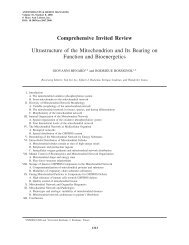MiPsummer Programme pdf - Mitochondrial Physiology Society
MiPsummer Programme pdf - Mitochondrial Physiology Society
MiPsummer Programme pdf - Mitochondrial Physiology Society
Create successful ePaper yourself
Turn your PDF publications into a flip-book with our unique Google optimized e-Paper software.
58<br />
The Implications of Apolipoprotein E Deficiency on Cardiac <strong>Mitochondrial</strong> Oxygen<br />
Consumption.<br />
C. Rocha 1 , C. Scheede-Bergdahl 2 and A. Bergdahl 1<br />
1 Department of Exercise Science, Concordia University, Montreal, Canada, 2 Department of<br />
Kinesiology and Physical Education, McGilll University, Montreal, , Canada,<br />
Methods: 2 month old female, age-matched C57Bl/6<br />
(Control) or ApoE-/-- (Experimental) mice<br />
were used. <strong>Mitochondrial</strong> OXPHOS capacity was measured in permeabilizep<br />
ed cardiomyocytes by<br />
high-resolution respirometry in a cross-sectional design. <strong>Mitochondrial</strong> content was assessed by<br />
citrate synthase activity and immunoblottings of the<br />
voltage-dependent anion channel. Furtherr<br />
immunoblottings weree done to determine thee relative expressions of o the 5 OXPHOS complexes.<br />
Background: Apolipoprotein E (ApoE) is a class of macromolecules foundd in chylomicrons and<br />
low- and intermediate-density lipoproteins. They are essential for normal n catabolism of triglyceride-<br />
rich substances and are, as such, determinants of lipid metabolism<br />
m. Absence or structural mutations<br />
of ApoE will result<br />
in impaired plasma clearance of cholesterol andd triglycerides. As a<br />
consequence, lipids will be shunted into non-oxidative pathways that ultimately disrupt normal<br />
cellular function.<br />
Objectives: The objective for this project was to determine the effects of disturbed ApoE mediatedd<br />
metabolismm on mitochondrial oxidative capacity.<br />
Results: The in-situ study of mitochondrial<br />
function revealed a highly significant, , 50%<br />
decrease (p=0.002) state 2 respiration (basal, ADPstate<br />
3<br />
restricted) in the ApoE-/- mice whereas the<br />
(maximal, ADP stimulated) respiration was similar<br />
in both groups. Furthermore the respiratory r control<br />
ratio was 15% higher<br />
(p=0.05) in i the heartt tissue<br />
from the ApoE-/- mice while the mitochondrial<br />
leak, estimated as antimycin A flux f subtracted by<br />
oligomycin<br />
flux was reduced by 11% (p=0.05).<br />
Abstract # 29<br />
Conclusion: The results indicate<br />
that lack of ApoE, even in youngg animals, will affect the coupling<br />
between oxidation and phosphorylation within the cardiac mitochondria. Additional work is<br />
necessary to clarify the potential damaging effects<br />
of this reprogramming of bioenergetics.<br />
Modified substrate metabolism followingg a lack of ApoE and subsequent augmentation of<br />
cholesteroll and triglyceride levels, seems to initially<br />
alter the energetic demands off the heart.<br />
Additional<br />
studies need to be performed too define the<br />
functionall underpinnings and whether this<br />
condition ultimately contributes to t heart failure.



